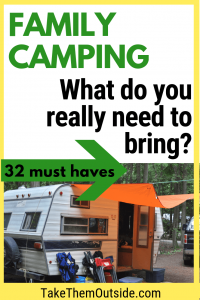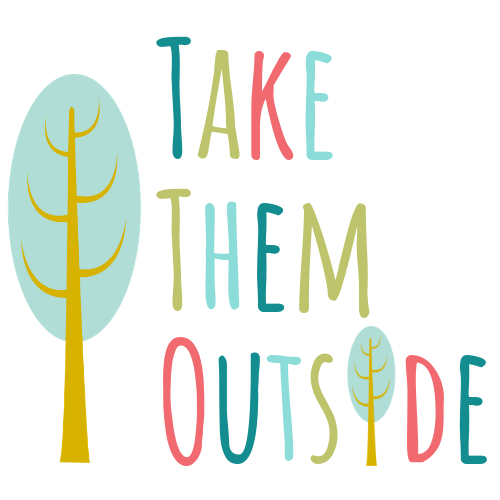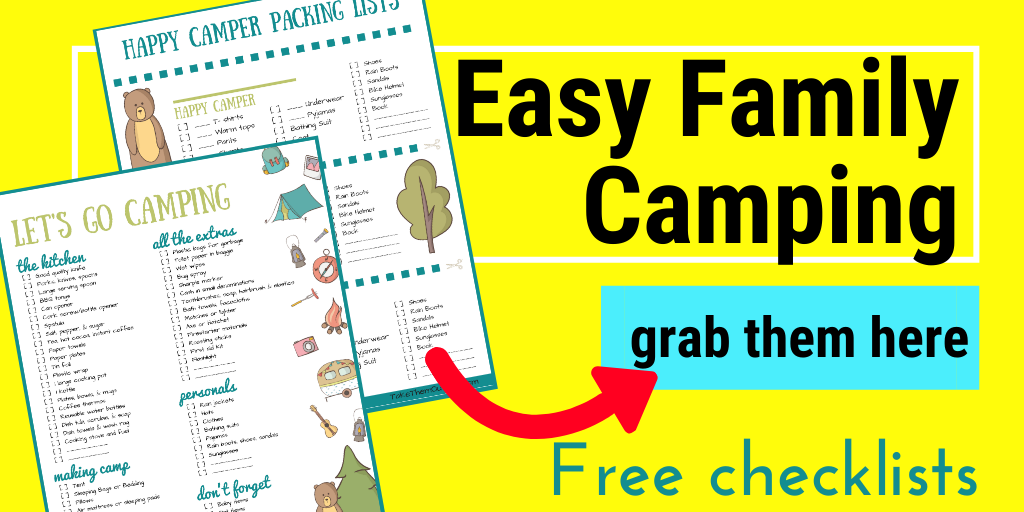Packing and planning for family car camping can be as easy or as hard as you’d like to make it. The simplest way to make camping easier is a two step process. First, decide which items are your necessary things for camping – all those camping essentials to ensure a successful camping trip. And secondly, don’t bring too much extra stuff!
The simplest way to make sure you’re sticking to just the essentials is to use a camping packing list and stick to it!
What are the 4 most important things to bring when you go camping?
Basically, you’ll see that all the camping essentials fall into these basic four categories:
- Shelter (what you’ll sleep in, on, or under and keep you protected from the elements)
- Food (eating, drinking and the gear to help that happen)
- Safety (protection from the elements, keeping warm, first aid)
- Comfort (a few things to make camping easier, more enjoyable, and all those other little important extras)
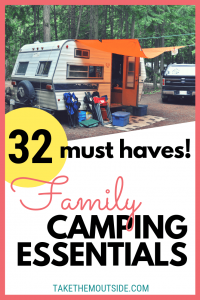
(This post contains affiliate links for your convenience. If you make a purchase through my link I receive a small commission at no added cost to you. I only recommend stuff I use and enjoy. See my policy page for more information)
What are the necessities for camping?
Well, ultimately there will be some personal preference in what’s a camping necessity and what isn’t. However, you’ll find this detailed list that follows contains what many would consider the most important essentials to bring along for a comfortable family camping trip, not a minimalist camping trip.
While you’re reading through the list, consider if you can manage without or if you’d like to bring it along. Everyone’s comfort levels are different!
This list is intended for families that are car camping and that are content to camp without electricity…. simple camping. Remember, you can always bring more things along with you… these camping items are just your starting point!
1. Shelter: The Essential Camping Gear
Something to sleep in: If you don’t have a camper, you’ll need a tent. If your family is adventurous you might even want to try hammocks, or tarp-tent shelters. Visit this article for tips on choosing the perfect tent for your family.
Sleeping Bags or Bedding: Each member will need something to sleep in. If it’s cold, bring extra blankets and your top-quality sleeping bags. If it’s hot, use DIY sheet sacs or lightweight blankets and sleeping bags.
Remember, follow these tips for proper care and cleaning of sleeping bags if you want to keep your sleeping bag in top condition.
For your babies and toddlers, you might choose to use a sleep sack and extra blankets instead of a sleeping bag to ensure they stay covered up through the night.
Wondering how to choose the perfect sleeping bag for your camping situation? This article by REI explains everything you ever wanted to know about camping sleeping bags!
Here’s a quick tutorial on how to make a sleep sack out of a sheet. You could skip the pillow pocket and it would be even easier to make!
Pillows: You can either bring your regular house pillows, keep pillows in the camper or your camping supplies, or use travel or camping pillows. Our camping pillows are now all lumpy and quite uncomfortable and we prefer our regular pillows.
Air mattress or sleeping pads: If you’re not hauling beds along to the campground, then you’ll probably want a cot, air mattress, or camping mattress for each person.
Do your research when it comes to sleeping pads. Some air mattresses are quite thin or deflate over the course of one night. Some camping pads will have better insulation levels than others. And, there is a wide price difference between them all.
Read here for expert advice on the most comfortable way to sleep in a tent.
This video is a quick overview of your various types of camping mattress options:
Air pump: If you’re bringing an air mattress, you’ll need to make sure you can inflate it. If it’s an electric pump, will you have electricity at the site?
Special sleeping aids: Don’t forget that tatty blanket or matted bunny that your little one just can’t sleep without. You might also appreciate having some ear plugs so you’re not being woken by other campers (or strange noises) through the night.
Clothing: You’ll need to plan for the weather. Rubber boots, sandals, coats, hats, bathing suits, pajamas, and an assortment of cool and warm weather clothing depending on your camping climate.
Folding camp chairs: While perhaps not an absolute necessity for camping, having a comfortable chair with back support can be really nice; otherwise, you’re sitting on crates, stumps, the ground, and possibly a bench for the whole trip.
Tarp and ropes: If shade is needed or you’re concerned about rain, bring along a tarp or two. Make sure your ropes are long enough to stretch across the campsite and if you are camping without trees you may want to bring something to use as a support pole.
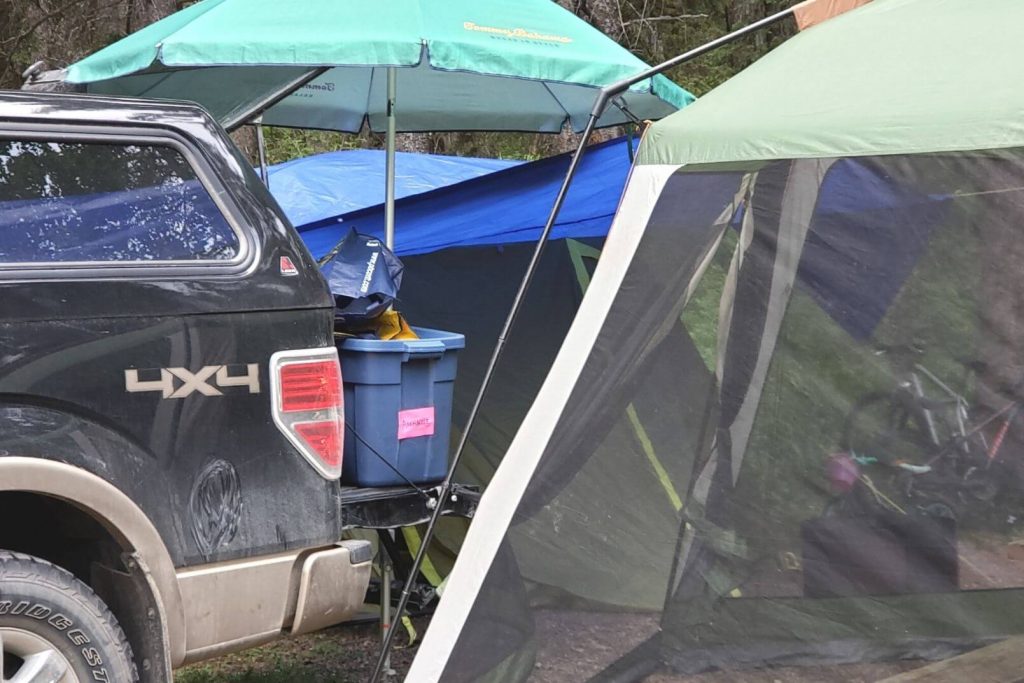
Read this article for expert tips on staying dry while car camping in the rain.
2. Food: The Camping Essentials for your Camp Kitchen
Good quality knife: You don’t want to find yourself slicing a watermelon with a plastic butter knife!
Super tip: Knives with their own holder or sleeve will protect fingers when digging through the camping kitchen tub.
Multipurpose tool / knife: One of these are handy to bring along for small fix-it jobs and other mishaps.
Forks, knives, spoons: Make sure there’s one of each for each camper, then throw in a few extra for serving and cooking. You could also use sporks, these are the ones we use!
Large serving spoon and spatula: Long-handled utensils makes it easier and safer to stir stew and flip pancakes over the campfire
Can opener, cork screw/bottle opener: Your regular old hand-held, basic one will do… but really, this is only a camping necessity if you plan on bringing anything that you can’t open with your bare hands or your multi-tool.
Paper towels: Handy for messy spills, messy hands, and messy meals.
Tin foil: You’ll need good quality foil if you plan to cook any foil meals over the fire. You can also use the foil to keep left-overs for later. Remember that tin foil can be washed, reused, and recycled.
Large cooking pot: If you’re a large family or plan to do more involved cooking you may want to bring a few pots. Second-hand camp cooking pots are great, lightweight options for camping. You might find a set with different sized pots and a fry pan. You could also just pick up whatever’s available at your local used store or if you don’t need to worry about weight.
Here’s a guide to campfire cooking kits and you can see which ones we use for our camping adventures.
Water jug: If you don’t have a camper with water hook-up, having a large jug of water at your site will save many trips to and from the nearest water tap.
Plates, bowls, & mugs: One for each person plus a few extra for cooking and serving. If you really wanted to do minimalist packing, you could bring just one enamel camping mug per person and use that to eat out of as well!
Dish tub, wash rag, dish towels, & soap: Unless you plan to haul all your dirty dishes home, you’ll have to wash them at the campsite. You’ll find it easiest to have 2 or 3 tubs for washing, towels to lay the dishes on to dry, a scrub pad, and a wash cloth. But, again, some campers will manage without all these dish washing accessories.
READ MORE: Get tips on washing dishes while camping here!
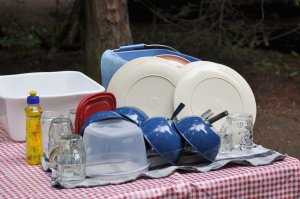
If the campground you’re visiting has a wash station, you could do without the tubs, but you’ll still want a way to transport your dirty dishes to the sinks and clean dishes back from the wash station.
Cooking stove and fuel: Even if you plan to use the campfire for all your cooking, it is advisable to have a camp stove with you in case you are unable to have a fire.
Most car campers use a typical propane camp stove with 2 burners and a small fuel tank, like this Coleman classic camping stove. Some campers will bring along a lightweight backpacking single burner stove, like this one we have.
If you have a stove in your camper and are comfortable using that for all your needs, then you shouldn’t need an extra cooking source.
Plastic bags for garbage: You’ll need to keep your garbage packaged and away from animals. The best way to do this is to have a few plastic shopping bags on hand. Then, throw your filled garbage bags into the dumpsters at the campground. Some campgrounds will have recycling facilities as well.
If you’re wilderness camping, keep your garbage in a sealed bag, in your vehicle, or in the animal safe location you keep all your food. Large black garbage bags can also be turned into rain ponchos if needed, dry sitting spots, and for bringing home dirty and wet clothes.
And Lastly, the food: Make sure you’ve got enough to feed everyone, then add a little more. … and don’t forget the marshmallows and snacks!
Read More: Check out this complete guide to the camp kitchen: 25 camping cooking essentials plus great tips and hacks too!
Looking for some new camping recipes? Check out 19 yummy Dutch oven recipes for breakfast, dinner, and dessert; or the best list of camping breakfast ideas.
3. Safety: The Camping Essentials of Protection and Rescue
Bug spray: Just bring whichever you think works best for you and your family.
Bear Spray: If camping in bear country, you should look into the locally commended ways to protect yourself and your family. Bear spray is usually one of the suggestions.
Learn more here about how to teach your children about bear safety.
Cash in small denominations: For unexpected costs like firewood, camp registrations, activity rentals, midnight vending machine snacks, and boat launch fees.
Matches or lighter, fire starter materials: It’s always important to have a lighter or matches for lighting propane stoves, candles, and camp fires. As for fire starter materials, just fill a small box with lightweight cardboard and newspaper or use your food containers as you empty them. You can purchase some fancy fire starter blocks too if you’d really prefer. But those are definitely not a camping essential!
Axe or Hatchet: If you plan on having campfires, you’ll likely need to split some smaller wood pieces for fire starting. Also, not all campgrounds split their provided fire wood.
First aid kit: Here’s the basics for you family camping first aid kit: Band-aids, small and large gauze dressings, disposable sterile gloves, tweezers, small scissors, triangular bandage, extra pads or tampons, alcohol swabs, safety pins, medical adhesive tape, anti-itch cream, anti-bacterial ointment and antihistamines (epi-pen?) and medication for pain and fever in age-appropriate dosages.
Here’s a video of a mom packing her family’s first aid and toiletry kit. You might get some tips and ideas of items you’d like to pack.
Flashlight / Headlamp / Lantern: You’ll want some way to light your way in the dark. Headlamps are particularly handy for night time reading, preparing midnight snacks, and changing 3am diapers.
Tip: your kids will likely each want their own flashlight or headlamp.
Toilet paper in a sealed bag: It is always a good idea to bring your own toilet paper along. If you have a camper, just throw some in a sealed bag and if/when the need arises, you have some on hand. Adding a small bottle of hand sanitizer is good too!
4. Comfort: All those extras which are nice, but not necessarily essential
You’d survive your camping trip just fine without these items, but it might be more enjoyable or comfortable if you did decide to bring these along as well. So, while I wouldn’t necessarily call them necessities for camping, they sure are nice to have (and for some campers might actually be on the essentials list… like toothbrushes!)
Bath towels, facecloths: This will depend on how long you’re camping, if you plan to shower or wash, or swim. It’s probably most convenient to bring along a towel for every camper, either a lightweight ultra-absorbing camping towel or your regular house towels are both good options.
Toothbrushes, soap, hairbrush & elastics: Remember, you’re camping… just bring along the basics.
Camping non-essentials, but could be handy to have along:
Salt, pepper, sugar, Tea, hot cocoa, instant coffee, drink crystals: Just some kitchen basics that you can throw into your camping kitchen tub for the whole season. Tupperware’s spice jars pack well together instead of round jars. They look like these.
BBQ tongs: These are very helpful in getting foil packets and hot dogs off the campfire grill. While you can manage with your regular cooking utensils, you might burn the hair off your knuckles attempting it!
Roasting sticks: In a pinch you can probably find a long thin stick, but keeping some roasting sticks in your camping gear is easy, especially if you use roasting sticks like these with telescoping handles.
Tip: tuck used roasting sticks into an empty cardboard gift wrap tube to protect your gear from their soot, dirt, and stickiness.
Reusable water bottles: A labelled or easily identifiable water bottle for each camper is a convenient way to keep everyone hydrated without creating an over-abundance of dirty glasses.
Coffee maker: Most campers bring coffee peculators to use on a stove or over the fire.
Coffee thermos: In cold weather it’s nice to have a thermos to keep your hot drink warm for longer. Again, not a necessity, but a comfort item that’s very handy to have with you. You can also keep hot water in one of these to have warm water on hand for washing up if you’re camping and don’t have access to hot water taps.
Kettle: For boiling water over a propane stove or on the fire. It’s handy to have a proper camping kettle, but it’s not a true necessity as you could always use a regular old pot to boil water for tea and washing up.
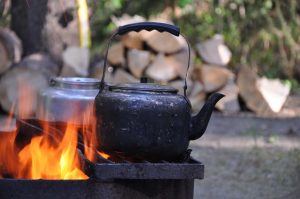
Dutch Oven: This is a popular cooking pot for making anything from stews to breads and desserts over the campfire. Again, not a necessity, but a very popular piece of camping cookware.
Folding Table: If your campsite doesn’t have a picnic table, having your own will be very handy. Some campers like to bring an extra table for outdoor cooking and food prep and set up a permanent outdoor cooking area under an awning or shelter.
Outdoor Rug: Using a rug or mat by your door will help keep debris out of your tent or camper.
Easy-up Shelter: Instead of stringing up a tarp, easy-up sun and bug shelters are very popular. If you’re camping in clouds of mosquitoes or black flies a screen shelter might quickly go from a camping extra to a camping essential. Some screen tents have floors, some do not.
A permanent marker: Because you never know when you’ll need to write on something.
Tip: Write your campsite number on the hands of all your children in case they get lost or forget their site number.
Duct tape: Because you never know when you’ll need duct tape.
Diversions: Okay, here’s the last suggestion. For some families having camping games and toys along will have more priority than other families… you’ll know your kids best! But, if you want some ideas here are some suggested reads:
Campground activities to make sure your kids aren’t bored!
The best camping games and toys for kids and families.
Okay, there you have it! Your complete list of family camping necessities plus a few extras! So, what should you do now? Well, you’ll want to make sure you have all these items written down so you can make sure you’ve got them all packed in your camping gear and ready to go. Grab this downloadable and printable camping planner set to do just that!
Then, you might want to read about how to organize and pack up all these camping essentials… and if that’s the case, head over to find out how we pack and plan for simple and stress-free family car camping.
Happy camping!
Other camping articles to head to next:
